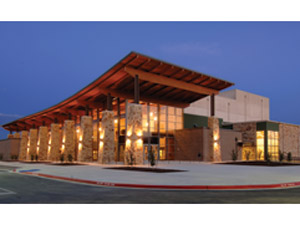The $4 million conversion of a former print shop and loading dock at Queensborough Community College into a new 8,000-sq-ft resource center, with 2,000 sq ft of new construction, was a straightforward job once the designs were in place. Aside from diverting a campus roadway six or seven feet, the custom steel storefront system’s most challenging aspect was perhaps the different types of glazing on the curtainwall and the non-standard grid pattern of the mullions.

Collaboration on the new Harriet and Kenneth Kupferberg Holocaust Resource Center and Archive was key on the project, with stakeholders including the Kupferberg family, the Dormitory Authority of New York, CUNY, Queensborough College, and the existing Holocaust resource center on the campus, which was previously housed in the basement of the college library.
Before shovels went in the ground, however, a lot of thought had to go into what constitutes an appropriate design for such a space.
“There’s an emotional aspect, but I find that that helps,” says Charles Thanhauser, principal at TEK Architects, the designers on the project. “The concern for us here was, how do you make something that’s not a Disneyland of death? We wanted something that was a learning center, but also something that wouldn’t be confused with an entertainment center.”
To achieve this, the team experimented. Normally, an architect makes three-four models of a building; for the center, TEK made 35.
What they came up with was a simple curtainwall facade enclosing a flexible space for a library, archives, meeting and office space, and galleries. The facade’s mullions, straight on some parts of the building, gradually take on a more irregular geometry on parts of the wall.
“The majority of the building is translucent glass and transparent glass,” Thanhauser says. “The idea is that in certain areas it’s supposed to take a fractured, irrational look, like it’s been broken. Like a veiled reference to the irrationality of things and Kristallnacht.” [Kristallnacht, or Night of Broken Glass, was a pogrom by SA stormtroopers and civilians on Jews across Germany and Austria in November 1938, when thousands of Jewish business were destroyed, and 1,700 synagogues vandalized or set on fire. In all, 91 Jews were killed and 30,000 Jewish men were sent to concentration camps, many of them never returning.]
The glass slides out from under a zinc paneled roof that wraps around the back and encloses the two entrances. Next to it is a 1,500-sq-ft terrace, perched on a hill for the best vantage point and clad in Jerusalem granite, a material seldom used in New York but one the architects embraced as relevant. The choice was actually a suggestion from Harriet Kupferberg, who got involved with the project despite her husband passing away right before the team broke ground, and remained involved until its completion.
Key Players
Developer/Owner: City University of New York
General Contractor: Summit Construction, New York
CM: Hill International, New York
Architect: TEK Architects, New York*
*Submitted Project to New York Construction

Post a comment to this article
Report Abusive Comment